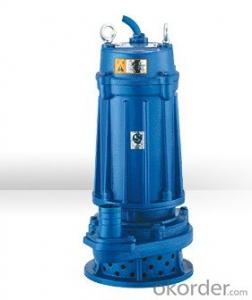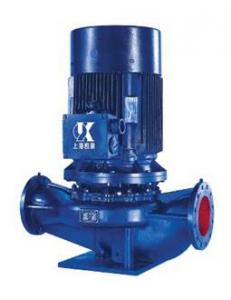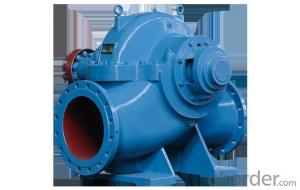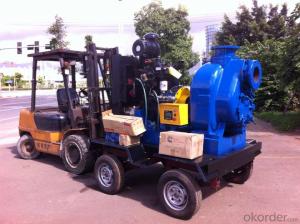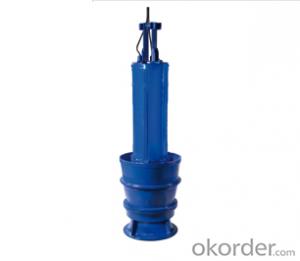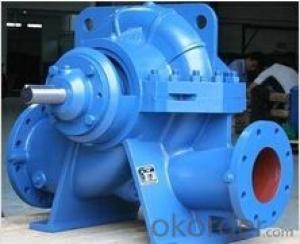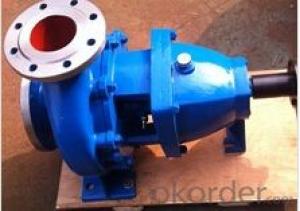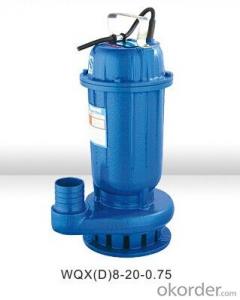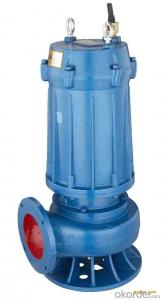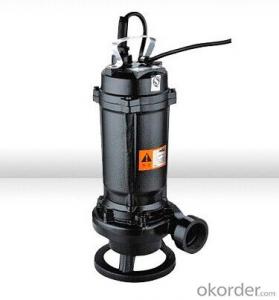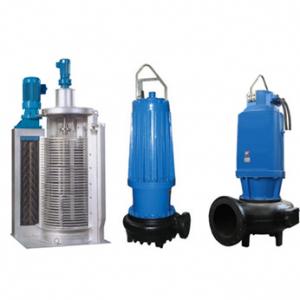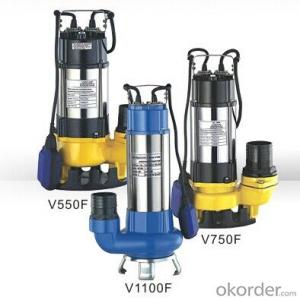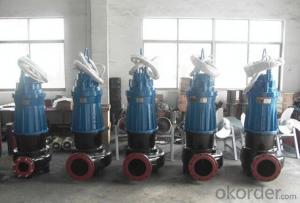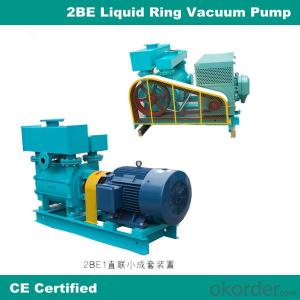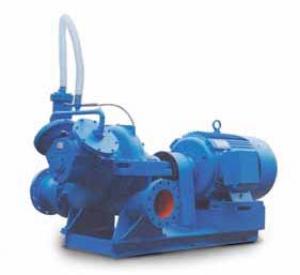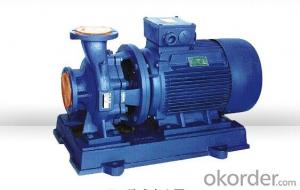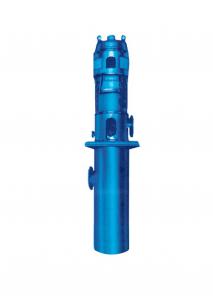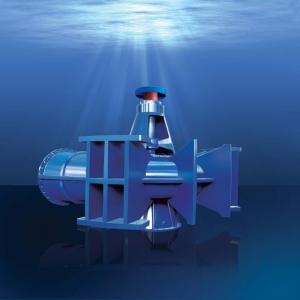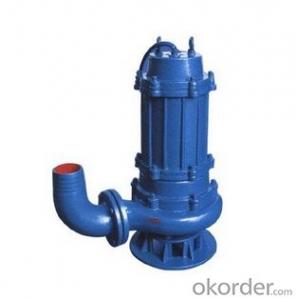WQK Sewage Submersible Pump
- Loading Port:
- China Main Port
- Payment Terms:
- TT OR LC
- Min Order Qty:
- -
- Supply Capability:
- -
OKorder Service Pledge
OKorder Financial Service
You Might Also Like
Packaging & Delivery
| Packaging Detail: | Wooden packaging |
| Delivery Detail: | Within 20days after receipt of your order payment |
Specifications
1.Submersion depth 5m
2.Head up to 35m
3.Flow rate up to 1800L/min
4.Passage of suspended solid up to 35mm
Range of Performance
Flow rate up to 1800L/min(108m3/h)
Head up to 35m
Application and Installation
They are recommended for draining dirty water and sewage in the domestic and civil sectors. Being equipped with a single-channel impeller, they are allowed to pump liquids containing suspended solid bodies with dimensions up to 35 mm and short fibres. They are ideal for pumping drainage water, sewage or waste water for a single dwelling, and for clearing surface or nuisance water. These pumps are outstanding in their reliability in fixed installations with automatic operation.
Operating Conditions
Submersion depth 5m
Liquid temperature up to +40oC
Ambient temperature up to +40oC
Max. Working pressure: 6 bar
Passage of suspended solid up to 35mm
Structure Feature
Pump body: Cast iron
Motor bracket: Cast iron
Impeller: Cast iron
Motor shaft: SS 420 or CS 45#
Mechanical seal: Ceramic - Graphite, Silicon carbide-Carbide alloy
Electric motor: Single-phase 220V - 50Hz with capacitor and thermal overload protector, three phases
380V -50Hz, Voltage fluctuation for 10% more or less is allowed and other voltage for 60Hz is also available.
Insulation: Class E
Protection: IPX8
- Q: Why does the centrifugal pump close the pressure to start?
- Therefore, the operation rules of multistage centrifugal pumps require that the inlet valve be opened before opening, and the outlet valve is closed. However, the export valve closed time can not be too long, because at this time the medium in the pump cycle, the medium temperature gradually increased, easy to cause mechanical seals, due to lack of lubrication friction and wear or damage.
- Q: What are the uses and precautions of magnetic pumps?
- 2, when the suction surface above the pump axis, before starting the valve can open the suction pipe, if the aspiration level below the pump axis, the pipeline to be equipped with bottom valve;3, the pump should be checked before use, the motor blade rotation to be flexible, no jam, no abnormal sound, the fasteners should be tightened;4 、 check whether the motor rotation direction is consistent with the magnetic pump steering mark;
- Q: What are the ways of hydraulic pumps?
- Hydraulic pump is a power component of hydraulic system. It is driven by an engine or an electric motor. It draws oil from the hydraulic tank to form a component of the pressure oil which is sent to the actuating element.
- Q: What does "anti pump" mean in pump operation?
- Function: anti pump effect when used for pumping concrete pumping occurs overpressure, the pumping pressure is above 25MPA, the concrete conveying pipe out of ash, can be understood as the precursor of pipe blockage, at this time should immediately use the anti pump, the concrete from the conveying pipe in the suction into the hopper, thus preventing plugging happen
- Q: Difference between pump and compressor
- A pump is a machine that transports liquids or pumps liquids. It transfers mechanical energy or other external energy of the prime mover to the liquid, increasing the energy of the liquid. The pump is mainly used to transport water, oil, acid and alkali liquid, emulsion, suspension emulsion and liquid metal, and also can transport liquid, gas mixture and liquid containing suspended solid. Pump can usually be divided into three types of displacement pumps, power pumps and other types of pumps according to the principle of operation. In addition to classification according to the working principle, it can be classified and named according to other methods. For example, according to the driving method can be divided into the electric pump and the turbine pump; according to the structure can be divided into single-stage pump and multistage pump; use can be divided into the boiler feed pump and the metering pump; according to the nature of transmission fluid can be divided into water pump, oil pump and mud pump etc.. In accordance with the non axial structure, can be divided into linear pumps and traditional pumps.
- Q: What is the difference between centrifugal pump and rotary vane pump? What are the distinctive characteristics or principles of rotary and centrifugal? O (a _ U) O thank you!
- Directly said vane pump on the line, generally do not say rotary vane pump.The centrifugal pump is divided according to the direction of the liquid flow in the impeller
- Q: What are the parts of a pump? How do you classify it?I just want to know
- According to the working principle can be divided into: centrifugal type and volume type centrifugal pump. By the centrifugal force of the impeller will accelerate the refrigerant, through to stay, so as to achieve the purpose of boosting; volume by changing the refrigerant in the flow volume to boost purpose.According to the media and installation conditions, water pump: centrifugal pump used: the impeller pump shaft, a curved blade on the impeller impeller outlet. The central entrance water vertically along the tangential direction of axial flow pump: high speed, large flow, low lift, mixed flow pump and centrifugal pump structure similar to that of the blade outlet angle is different, wide flow channel, close to the performance of axial flow pump displacement pump: safety valve must be opened before the start (metering pump, screw pump)
- Q: Is vane pump good or gear pump good?
- The main working parts of vane pump is provided with a plurality of sliding vane rotor, when the rotor rotates, the eccentric configuration of stator cavity contour or rotor, blade sliding slot in leaves due to volume changes, resulting in the suction effect. The similarities are: 1, rotary type positive displacement pump has self-priming ability, but are not allowed to do; 2, with continuous flow pulsation, but also have flow and pressure; 3, the theory of flow is determined by the working parts of the size and speed, has nothing to do with discharge pressure; 4, rated discharge size, pressure and working parts mainly depends on the pump speed is independent of the sealing parts and bearing capacity; differences: 1) gear pump structure is more simple, reliable, low price; vane pump has complicated structure and high manufacturing precision parts, the blade is easy to get stuck, more sensitive to the oil clean degree and viscosity.
- Q: Metering pumps related matters
- 1., exports higher than imports, avoid siphonage2. the pump head and the injection valve require vertical installation3., the attached pipe can be tightened by hand, please do not use the tool; the thread does not use the raw meal belt4. the supply voltage is stable and grounded5. installation environment clean, spacious, well ventilated) 1) metering pump suction is not normal
- Q: What is the distance between the pump and the wall?
- What do you mean by that? If your pump is parallel to the wall! Then, the wall of the pump near the wall is usually 500mm. This is an empirical data, considering the import pipe length, pump maintenance and motor heat dissipation and other aspects of the situation to determine. Dozens of pumps installed in our company are placed in this size! Hope to be of help to you.
Send your message to us
WQK Sewage Submersible Pump
- Loading Port:
- China Main Port
- Payment Terms:
- TT OR LC
- Min Order Qty:
- -
- Supply Capability:
- -
OKorder Service Pledge
OKorder Financial Service
Similar products
Hot products
Hot Searches
Related keywords
